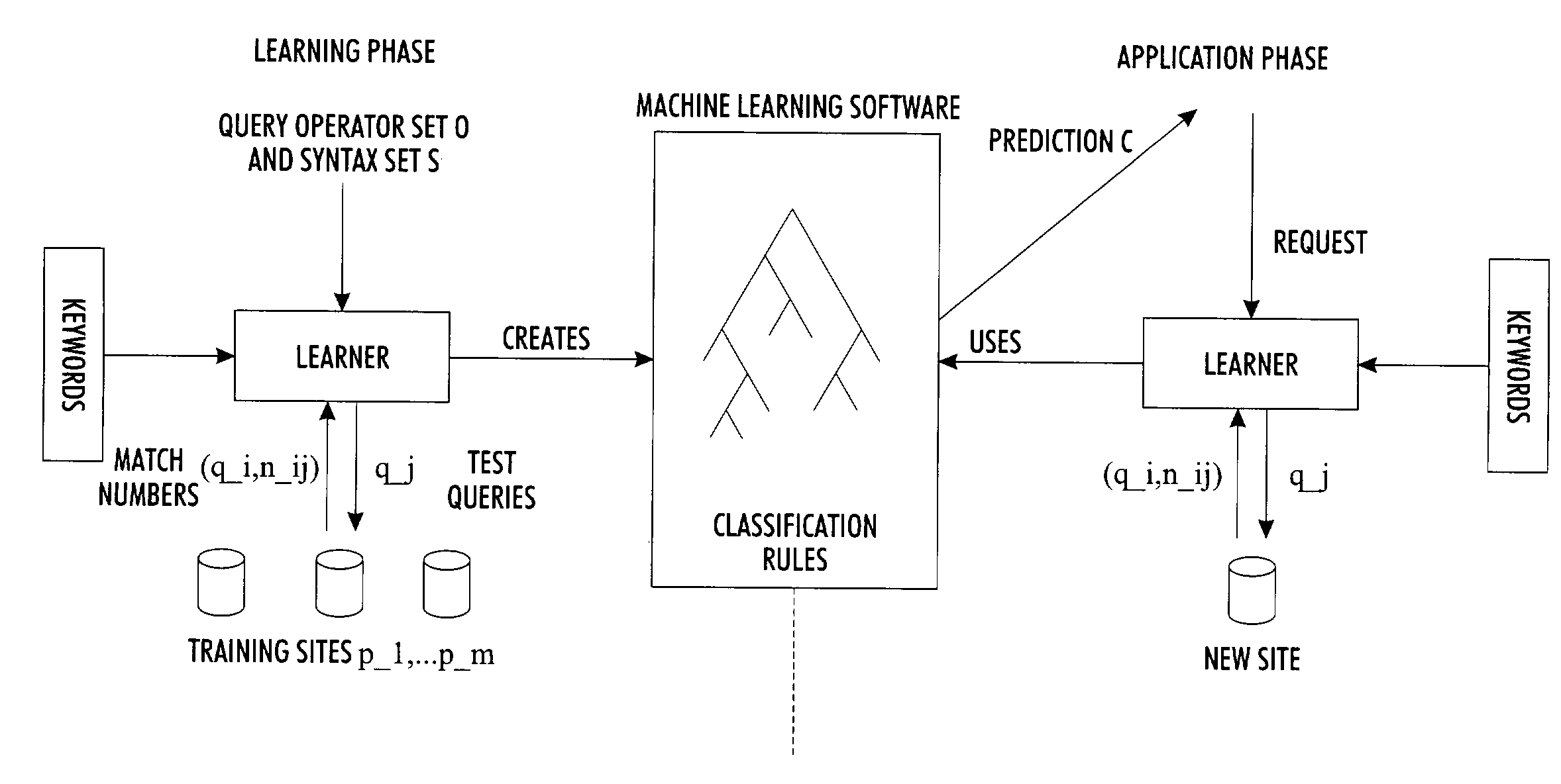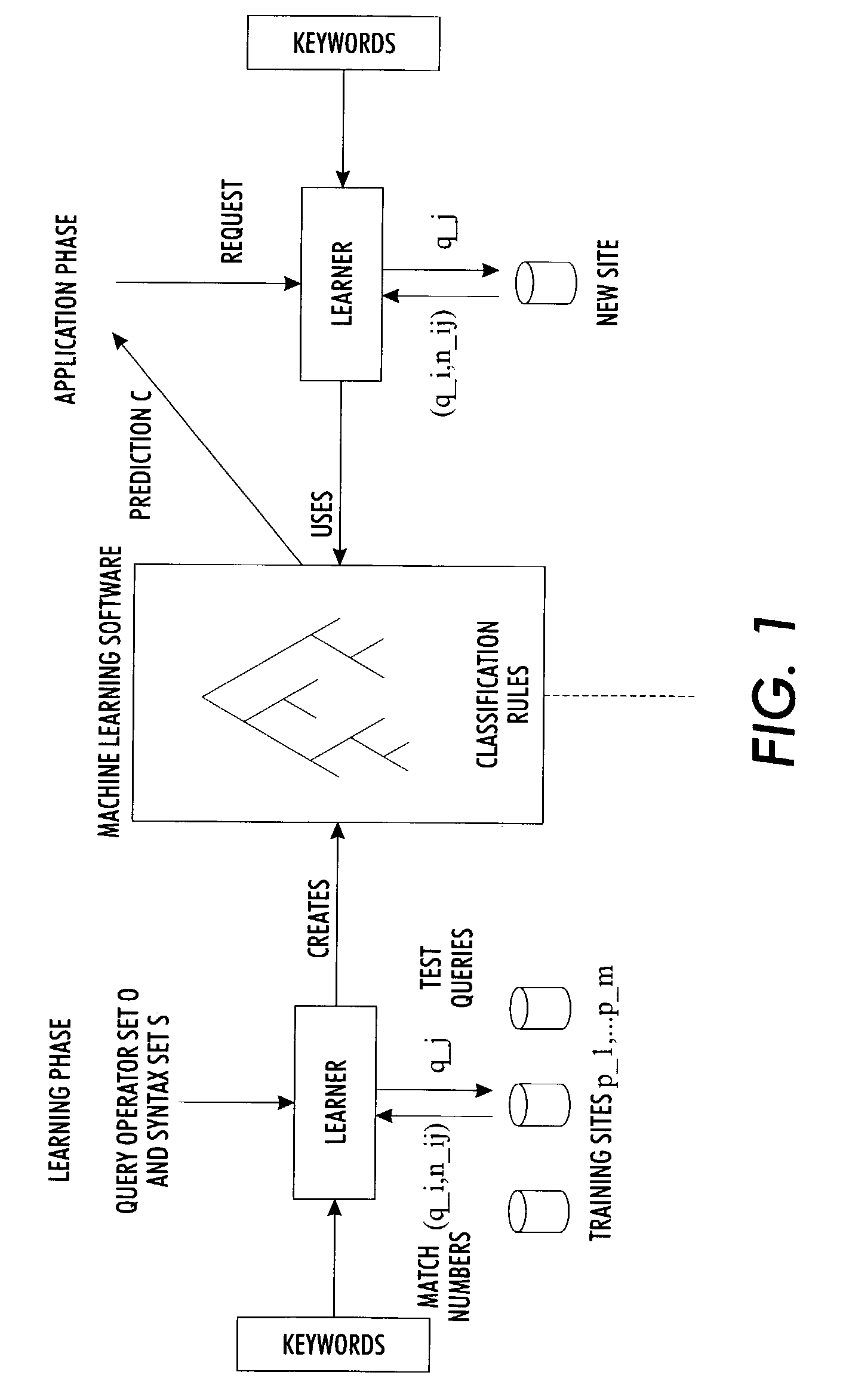Method for automatic discovery of query language features of web sites
a technology of query language and discovery method, applied in the field of information retrieval and integration systems, can solve problems such as complex differentiation, and achieve the effect of facilitating this analysis and comparison
- Summary
- Abstract
- Description
- Claims
- Application Information
AI Technical Summary
Benefits of technology
Problems solved by technology
Method used
Image
Examples
example 1
[0033]To illustrate the problem, consider the query string q=“Casablanca AND Bogart”. On Google (www.google.com), “AND” is interpreted as the Boolean conjunction, that is, iGoogle (“Casablanca AND Bogart”)=“Casablanca”“Bogart”. As result, query q matches 24,500 pages at Google, as opposed to 551,000 for query q1=“Casablanca” and 263,000 for query q2=“Bogart”.
[0034]On the Internet Movie Database (IMDB) (www.imdb.com / ), “AND” is taken literally and all terms in a query are implicitly OR-connected. Therefore, the IMBD interprets query q as follows: iIMDB (“Casablanca AND Bogart”)=“Casablanca”“AND”“Bogart”. The query returns 12,020 matches documents on IMDB, as opposed to only 22 for q1=“Casablanca” and 4 for q2=“Bogart”.
[0035]If we investigate an unknown query language, then Example 1 shows that observing match numbers for probe queries can provide a good insight on supported operators. However, no definitive decision appears possible from the three above queries q, q1, q2. An accurate...
example 2
[0036]As in Example 1, let us compare match numbers for queries q=“Casablanca AND Bogart”, q1=“Casablanca” and q2=“Bogart”. For Google, the fact that q matches fewer documents than either q1 or q2, favors the guess of conjunction, but is still insufficient to exclude other hypotheses, like that of phrase processing. Probing Google with query q3=“Bogart AND Casablanca” returns the same number of matched documents as q. This discards the phrase hypothesis, but not the hypothesis of “Casablanca”“AND”“Bogart”. To discard this one, even more queries be sent to Google, like q4=“Casablanca AND”, and so on.
[0037]The situation is similar with IMDB. The fact that query q matches more documents than q1 and q2 suggests that q is processed as a disjunction, but it cannot tell if “AND” is taken literally or ignored. A deeper analysis requires sending more probe queries to IMDB, for example, queries q4=“Casablanca AND” or q5=“Casablanca Bogart” to compare their match numbers to the ones of previou...
example 3
[0047]Let O include the three Boolean operators (, and ) and phrase. Then, for a given syntax set S, any ambiguous mapping M: O→2S can be exactly identified if the oracle is noiseless. (Oracle noise assumes the pure Boolean logic, with no query preprocessing, such as stop word removal.) In such a case, subset sizes returned by the oracle fit the Boolean logic on sets. Indeed, when querying the oracle with terms A and B and syntaxes from S, the disjunction is distinguishable from other operators by the fact that it constrains bigger subsets in a collection that any of terms:
|AB|>|A|, |AB|>|B|. (1)
Further, among three other operators, the conjunction is recognized by its commutativity:
|AB|=|BA|. (2)
Finally, the difference between negation and phrases is detected by the basic equation linking three Boolean operators, which practically (though not theoretically) distinguishes the phrase operator from the negation
|AB|=|AB|+|AB|+|BA|. (3)
Sizes of subsets constrained by Boolean o...
PUM
 Login to View More
Login to View More Abstract
Description
Claims
Application Information
 Login to View More
Login to View More - R&D Engineer
- R&D Manager
- IP Professional
- Industry Leading Data Capabilities
- Powerful AI technology
- Patent DNA Extraction
Browse by: Latest US Patents, China's latest patents, Technical Efficacy Thesaurus, Application Domain, Technology Topic, Popular Technical Reports.
© 2024 PatSnap. All rights reserved.Legal|Privacy policy|Modern Slavery Act Transparency Statement|Sitemap|About US| Contact US: help@patsnap.com










